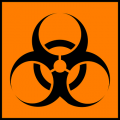DE FAAKTO INTELLIGENCE RESEARCH OBSERVATORY
INTELLIGENCE NEWS
SITUATION-WEAPONIZED ANTHRAX-TUNISIA-03 March 2019
BACKGROUND
News outlets-The National & Asharq Al-Awsat are reporting,
- 19 letters, addressed to prominent journalists, politicians and trade unionists, have been intercepted by police at the central Post Office in Tunis and taken for testing. It’s unclear at this stage how many letters have been sent
- The Tunisian counter-terrorism agencies have revealed in their preliminary investigations that the envelopes delivered to politicians, journalists and syndicate members contained the Anthrax toxin
- This was the first terrorist plot of its kind in the country
- Though Tunisia has faced extremist attacks in recent years, poisoned letters are unprecedented
- The country’s intelligence agency to urge the public to be cautious around unexpected post
- Investigations into the source of the letters remains ongoing but the government suspects extremists
- Terrorist groups have shifted their tactics after security measures against them have limited their activity.
- For years, they have relied on armed attacks, but they are now forced to resort to poisoning their victims, according to security agencies
- Terrorist group experts said that toxic substance letters is a method that has been adopted by several terrorist organizations in the past
THE NATIONAL https://www.thenational.ae/world/mena/tunisia-s-mysterious-poison-letters-spark-concern-of-new-terror-tactic-1.833787
ASHARQ AL-AWSAT https://aawsat.com/english/home/article/1615976/envelopes-containing-anthrax-delivered-major-tunisian-figures
WEAPONIZED ANTHRAX-FAAKT BOARD-ANALYSIS BY
DE FAAKTO INTELLIGENCE RESEARCH OBSERVATORY
Methodology-OSINT research
Situation –Anthrax
- A naturally occurring disease found in soil
- Weaponized agent used in bio-terrorist attacks
Background
What is anthrax?
- A serious infectious disease
- Caused by gram-positive, rod shaped bacteria known as bacillus anthracis
- Found in soil
- Affects animals-domestic & wild
- Global threat
- Transmission through infected animals or contaminated animal products
- Causes severe illness in humans & animals
Transmission
- Not contagious between humans
- Breathing in spores
- Consume food or water that is contaminated with spores
- Spores enter cut or scrape in the skin
Anthrax is more common in developing countries lacking veterinary health programs and is found in agricultural regions of:
- Central and South America
- Sub-Saharan Africa
- Central and Southwestern Asia
- Southern and Eastern Europe
- The Caribbean
- Sporadic outbreaks in USA wild domestic grazing animals
Who is at risk for anthrax?
- People Who Handle Animal Products
- Veterinarians
- Livestock producers
- Travelers
- Laboratory Professionals
- Mail handlers, military personnel, and response workers who may be exposed to a bio-terrorism event involving weaponized anthrax
Bio-terrorism & Anthrax
Anthrax is a likely terror weapon
- Anthrax spores are easily found in nature
- Anthrax can be produced in a lab
- Anthrax has been previously weaponized
Anthrax is an effective weapon
- Releases quietly
- Tasteless
- Odorless
- Invisible
Delivery methods:
- Aerosolized anthrax-air dropped by aircraft or vehicle
- Powdered anthrax-mailed in envelopes
- Introduction of anthrax to food & water supplies
Antibiotic Post exposure-Prevention
- Ciprofloxacin and doxycyclin
Vaccination
- Anthrax Vaccine Adsorbed (AVA) protects against anthrax
Symptoms
There are extensive symptoms with anthrax this list is not exhaustive
Cutaneous anthrax symptoms can include:
- Blisters
- Sores
- Painless Ulcers of the neck, face, arms, hands
Inhalation anthrax symptoms can include:
- Fever and chills
- Chest Discomfort
- Shortness of breath
- Cough
- Nausea, vomiting, or stomach pains
- Sweating (often drenching)
Gastrointestinal anthrax symptoms can include:
- Sore throat
- Painful swallowing
- Nausea and vomiting, especially blood
- Bloody diarrhoea
Injection anthrax symptoms can include:
- A group of small blisters or bumps that may itch, appearing where the drug was injected
- A painless skin sore with a black center that appears after the blisters or bumps
- Swelling around the sore
- Abscesses deep under the skin or in the muscle where the drug was injected (CDC, 2018)
Assessment
De Faakto intelligence research indicates Anthrax will continue to be a threat. The CDC predicts that anthrax will be the most likely used agent for a bio-terrorism attack in the USA. De Faakto concurs with this assessment because anthrax spores are found naturally and, alternatively can be manufactured in a lab. Anthrax was weaponized and disseminated through the U.S. postal system in a domestic terror incident in 2001. Powdered anthrax spores were mailed in envelopes, infecting twenty-two people and killing five. Twelve of the anthrax victims were postal workers.
Recommendations
- Emergency organizations should plan for anthrax incident/attack
- Anthrax education and training for front line responders
- Understand anthrax risk, threat, mitigation, recovery cycle
- Consider special teams trained and equipped to deal with anthrax threat
- Consider immunization of workers with Anthrax Vaccine Adsorbed (AVA)
- Encourage & facilitate immunizations for staff at high risk of exposure-HAZMAT, CRBNE, Tactical Teams
- Ensure proper PPE, special equipment acquired and available for responders
- Consider stocking ciprofloxacin and doxycyclin antibiotics to expedite treatment in the event of Anthrax exposure
- Autonomous self supporting units should prudently consider stockpiling antibiotics
- Organizations that prepare for anthrax incident/attack attain training value for similar HAZMAT/CBRNE incidents
Safety
PPE used should be proportional to the risk anticipated for,
- The task workers will do
- Degree of contamination
- Risk of exposure
- PPE includes appropriate respiratory protection, protective garments (e.g., coveralls, boot covers, chemical-resistant or -impermeable suits), eye and face protection, and gloves (nitrile or vinyl)
Dept. Homeland Security- PPE Recommendations
- Level C protective ensemble with a full face piece air purifying respirator (APR) with P100 or N100 filters
- OR Level C protective ensemble with a full face piece powered air purifying respirator (PAPR) equipped with high efficiency (HE) filters
- Disposable hooded coveralls and shoe coverings
- Nitrile or vinyl gloves (DHS, 2012)
Other safety practices and considerations
Thoroughly wash hands with soap and water upon removing gloves,
- Before eating
- When replacing torn or worn gloves
- Remove gloves prior to leaving the work area and place them in areas specifically designated for storage, washing, decontamination, or disposal (OSHA, 2018)
Resources
Anthrax-U.S. Government-Center for Disease Control (2018) https://www.cdc.gov/anthrax/basics/index.html
Protecting Workers from Anthrax-U.S. Government-Center for Disease Control (2018) https://www.cdc.gov/niosh/docs/2002-142/pdfs/2002-142.pdf?id=10.26616/NIOSHPUB2002142
Guidance for Protecting Responders’ Health during the First Week Following a Wide-Area Aerosol Anthrax Attack –U.S. Government –Department of Homeland Security (2012) https://www.dhs.gov/sites/default/files/publications/Guidance%20for%20Protecting%20Responders%27%20Health%20-%20October%202012_0_0.pdf
Anthrax-U.S. Government-Dept. of Labor-OSHA (2018) https://www.osha.gov/SLTC/emergencypreparedness/anthrax/controlandprevention.html#specific_work
Disclaimer-De Faakto Intelligence Research is provided to first responders for situational awareness, advice, guidance and educational purposes. Intelligence is perishable and fluid. Intelligence is updated and reassessed as new information becomes available. Sources are evidence based and multiple sources are used when possible. Sometimes intelligence assessments present gaps in information, this is a reality in intelligence led operations and gaps are filled when information presents. Emergency first responders should always follow best industry practices, organizational policy-procedures and regulatory standards.






